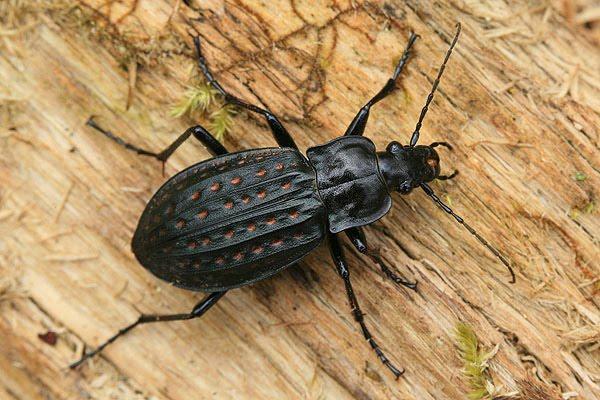Scientific classification
Kingdom: Animalia
Phylum: Arthropoda
Class: Insecta
Order: Coleoptera
Suborder: Adephaga
Superfamily: Caraboidea
Family: Carabidae
Ground beetles are a large, cosmopolitan family of beetles, Carabidae, with more than 40,000 species worldwide, approximately 2,000 of which are found in North America and 2,700 in Europe.
Description and ecology
Although there is some variation in their body shape and coloring, most are shiny black or metallic and have ridged wing covers. Typical for the ancient beetle suborder Adephaga to which they belong, they have paired pygidial glands in the lower back of the abdomen. These are well developed in ground beetles, and produce noxious or even caustic secretions used to deter would-be predators.
Common habitats are under the bark of trees, under logs, or among rocks or sand by the edge of ponds and rivers. Most species are carnivorous and actively hunt for any invertebrate prey they can overpower. Some will run swiftly to catch their prey; tiger beetles (Cicindelinae) can sustain speeds of 8 km/h (5 mph) – in relation to their body length they are among the very fastest land animals on Earth. Ground beetles are generally reluctant or even unable to fly.
Relatinoship with humans
As predators of invertebrates, including many pests, most ground beetles are considered beneficial organisms. The caterpillar hunters are famous for their habit of devouring insect larvae and pupae in quantity, eagerly feeding on tussock moth caterpillars, processionary caterpillars and woolly worms, which due to their urticating hairs are avoided by most insectivores. A few species are nuisance pests. Zabrus is one of the few herbivorous ground beetle genera, and on rare occasions Zabrus tenebrioides for example occurs abundantly enough to cause some damage to grain crops.
They are important mamabers of soil ecosystem playing role in organic matter mineralisation. Abundance and diversity of ground-beetles is a common indicator of the quality of the terrestrial environment.
